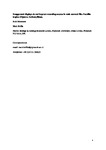Exaggerated displays do not improve mounting success in male seaweed flies Fucellia tergina (Diptera: Anthomyiidae)
Date
2015-11Author
Subject
Metadata
Show full item recordAbstract
Signals of individual quality are assumed to be difficult to exaggerate, either because they are directly linked to underlying traits (indices) or because they are costly to perform (handicaps). In practise advertisement displays may consist of conventional and costly components, for instance where a morphological structure related to body size is used in visual displays. In this case, there is the potential for dishonest displays, due to the population level variance around the relationship between body size and display structures. We examine the use of wing flicking displays that we observed in situ in a strandline dwelling seaweed fly Fucellia tergina, using overall body size and the size of their eyes as underlying indicators of condition. Males displayed far more frequently than females, and were also observed to frequently mount other flies, a behaviour that was rare in females. The rate of display was greater for males that had positive residual values from relationships between wing length and body length. In other words those males with larger than expected wings for their underlying quality displayed more frequently, indicating that these displays are open to exaggeration. Males with larger than expected wings (for the size of their body or eyes), however, mounted less frequently. We suggest that small bodied males are less successful in terms of mounting, but that those small males with relatively large wings may attempt to compensate for this through increased display effort.
Publisher
Place of Publication
Journal
Volume
Pagination
Author URL
Recommended, similar items
The following license files are associated with this item:


